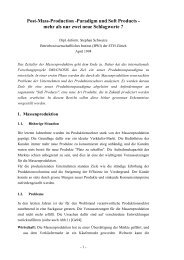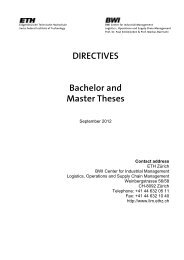The China Venture
The China Venture
The China Venture
You also want an ePaper? Increase the reach of your titles
YUMPU automatically turns print PDFs into web optimized ePapers that Google loves.
control compared to national enterprises. 69 A significant devaluation has not occurred for<br />
more than four years in <strong>China</strong>, therefore, many investors have become (too) complacent with<br />
a stable exchange rate and easy access to foreign exchange.<br />
FIEs have to gain their currencies, which they need for procurement from abroad,<br />
compensation of their foreign staff and for paying dividends to their foreign investors on a<br />
self-operating basis. <strong>The</strong> Chinese government supports them only poorly. <strong>The</strong> balancing of<br />
these foreign exchange positions is one of the most difficult tasks and therefore a high barrier<br />
for FIEs in <strong>China</strong>. In a controlled market like <strong>China</strong>, it is complicated to gain all the necessary<br />
currencies for the daily business. However, in spite of all techniques of hedging currency<br />
exposures, devaluation will fundamentally alter a company’s revenues and costs and thus its<br />
cash flow. If devaluation occurs, a company that imports parts and components to<br />
manufacture products that will be sold in <strong>China</strong>, must raise local currency prices to avoid<br />
losing money on every sale. Each investor in <strong>China</strong> should review their cash flow by currency<br />
and determine what impact various levels of devaluation would have on that cash flow. 70<br />
When a company’s assets and liabilities are denominate d in different currencies, changes in<br />
the relative value of the currencies involved will bring about a change in the relative value of<br />
the assets and liabilities. To avoid this, financial managers have the objective to keep the same<br />
ratio between currencie s on both sides of the balance sheet. By borrowing in the same<br />
currency as they will receive from future business, companies hedge against exchange rate<br />
risk. This is problematic when one of the currencies involved is the RMB. Firstly, rigid RMB<br />
maturities complicate matching. <strong>The</strong> dates for payment and repayment of the loans are often<br />
inflexibly set by the bank. Secondly, the interest rates on these loans can be preclusively high<br />
(see 2.3.3.2). Regulatory peculiarities also create exchange risks. Conversion of RMB into<br />
foreign currency for import payments are allowed not earlier than three months before<br />
payment. <strong>The</strong> importing company is exposed to a depreciating RMB from the point in time<br />
when the purchase was decided until three months before payment. A FIE selling on the<br />
domestic market is therefore exposed to the risk of a RMB depreciation in the period between<br />
the closing of the deal and payment, although the RMB is officially a fixed exchange rate.<br />
Since the crisis in Asia has seriously touched Japan and other competitor countries in Asia,<br />
the Chinese government could be forced to devalue the RMB in the next year. 71 <strong>The</strong> main task<br />
69<br />
See for more information Fan, 1994, pp. 208.<br />
70<br />
de Waal, 1998, p. 19.<br />
71<br />
See Madura, 1993, p. 136-140 and Fan, 1994, pp. 207.<br />
49






